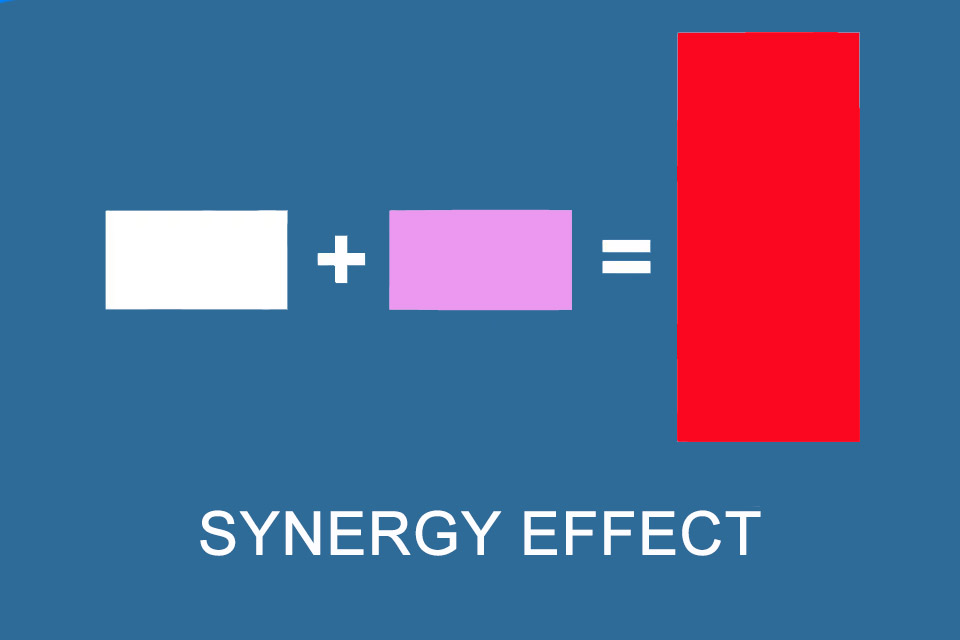What is a Synergy Effect?
Smartpedia:A synergy effect describes the combined effect of two or more things that is greater than the sum of the respective individual effects.
Synergy effect – the whole is greater than the sum of its parts
The word synergy comes from the Greek term “synergía” and translates as “cooperation”. What can organisations do if they want to increase turnover, reduce costs, expand competitive advantages or reduce risks? They can try to work together with other organisations to benefit from synergy effects.
A synergy effect is the combined effect of two or more things – in a business context1, for example, capabilities, capacities, market positions and market shares, reputation, resources, etc. – that is greater than the sum of the respective assets. Or as the Greek polymath Aristotle put it: “The whole is greater than the sum of its parts”.2
Positive and negative synergy effects
In general linguistic usage and also in the initiation of cooperations, synergies and their effects are often evaluated positively; however, synergy effects can be both positive and negative.
Example: Two car manufacturers (A and B) cooperate in the production of a new vehicle. Resources are shared, costs reduced, development times minimised. Such effects are very likely to be positive. Now, however, A has a very positive image and B rather a negative one; possibly, therefore, A’s image suffers through the cooperation with B. This would be a negative synergy effect.3 In a cooperation, therefore, both positive and negative effects can occur, and even simultaneously.
Many cooperations are based on the belief in positive synergy effects. Without this belief
- bidder consortia would not jointly attempt to win the contract for a tendered service.
- banking consortia do not attempt to establish joint project financing while minimising or spreading risk.
- industry consortia do not attempt to define common standards.4
However, faith and hope are not always enough in corporate practice. Involved parties should therefore do two things:
- List potential benefits with qualitative and quantitative assessment, and
- evaluate possible negative effects and disadvantages – also qualitatively and quantitatively.
Documentation can be done, for example, in the course of defining a business case. Furthermore, it can be very useful if the parties openly and honestly discuss the respective advantages and disadvantages, and consciously act and work in the direction of the positive effects. Good cooperation also thrives on the will for synergy.
Types of synergy effects
There are different types of synergy effects that can occur in different contexts. Here is a selection of the most important types:
Revenue synergy: The increase in revenue that can be achieved through the merger of two or more companies or business units is called revenue synergy. For example, a merger between two companies operating in complementary markets can lead to increased revenue and market share.
Cost synergy: A cost reduction can be achieved by merging two or more companies or business units. For example, a merger between two companies can lead to the elimination of duplicate functions and the sharing of resources, which in turn leads to cost savings.
Financial synergy: The improvement (or deterioration) of financial ratios are the result of financial synergies. For example, mergers change the capital structure, cash flow, debt capacity or profitability of the companies involved.
Operational synergy: The merger of two or more companies or businesses leads to an increase in efficiency and effectiveness. For example, a merger between two companies can lead to the sharing of best practices, expertise and technology, resulting in improved operations.
Strategic synergy: This refers to the benefits that can be achieved through the merger of two or more companies or businesses in terms of market positioning, competitive advantages and long-term growth. For example, a merger between two companies operating in complementary markets can lead to an increase in market share and provide the opportunity to expand into new markets.
Technical synergy: Advantages can be achieved by combining different technologies. For example, combining a wind turbine with a solar panel to generate electricity can lead to higher energy output and efficiency.
Product synergy: This refers to the benefits that can be achieved by combining two or more products. For example, combining a toothpaste with a mouthwash can lead to more effective oral hygiene.
Opinions vary as to whether these intended synergy effects require dedicated synergy management. So, of course, it might make sense to plan, implement and control measures and activities to realise the desired benefits. On the other hand, corresponding measures and activities are already addressed in the course of transformation projects, change management approaches or projects.
Impulse to discuss
How useful is it to qualitatively assess synergy effects in advance? Who benefits and what conclusions can be drawn for the future?
Notes:
[1] Synergy effects do not only occur in the corporate context or the economy. Synergy, synergy effects and synergism are also spoken of in chemistry and pharmacology, in forestry, in anatomy and also in philosophy and theology.
[2] “The whole is more than the sum of its parts” forms the basis of holism or the doctrine of wholeness. Natural and also non-natural systems (e.g. social systems) are considered as a whole and not only as a composition of their parts. The statement of Aristotle himself comes from his work Metaphysis, in which he dealt with the origin of being instead of only dealing with individual phenomena.
[3] “Ask your doctor or pharmacist” is probably the best known reference to negative synergy effects. Often medicines have side effects, especially when taken at the same time as other medicines, these can be very negative and counteract the intended effect.
[4] Here you can find more information on the topic of consortium.
Pair Working is another term that has emerged in the context of snyergy effects. It refers to the cooperation of two people who want to master a qualitative task or achieve a goal as a tandem.
Here you can find a German-language video on synergy effects, which shows correlations using the example of a merger of two automobile companies.
If you like the article or would like to discuss it, please feel free to share it in your network. And if you have any comments, please do not hesitate to send us a message.
Here you can find supplementary information from our Smartpedia section:



